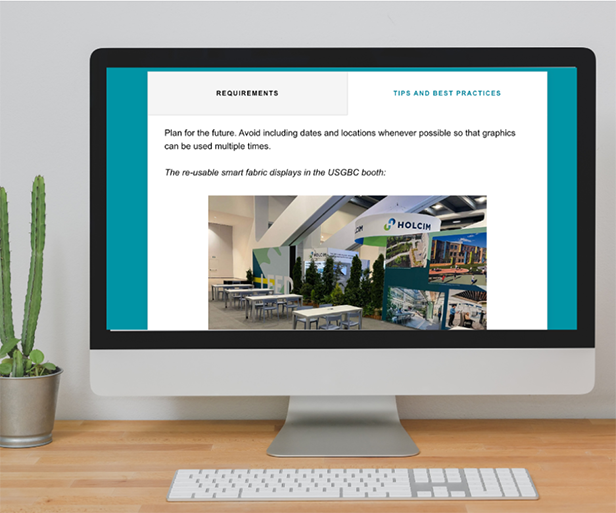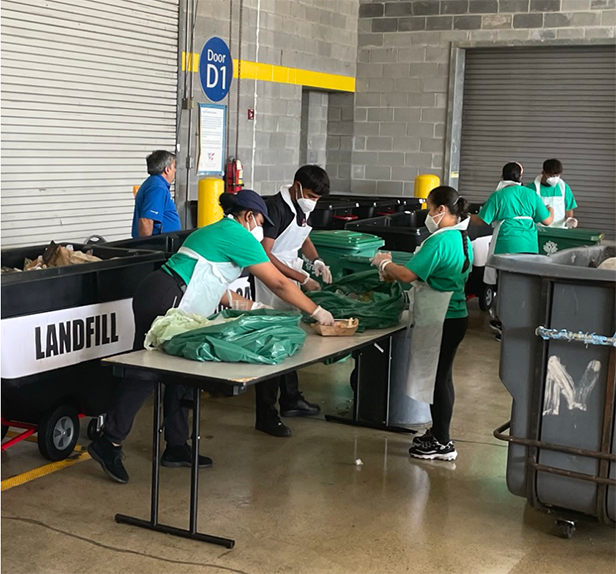Ahead of the Curve – Case Study: How Greenbuild Redefined Exhibitor Engagement

Exclusively sponsored by Honeycomb Strategies.
When it comes to sustainable innovations, one thing that sets apart Greenbuild International Conference + Expo is its sophisticated exhibitor engagement programs. Interlacing strategies for operations and communications have allowed Greenbuild to convince exhibitors of their stake in a sustainable event and to garner acclaim, awards and a stellar reputation. Along with their signature exhibitor requirement, the Greenbuild Mandatory Exhibitor Greening Guidelines (GMEGG), Greenbuild and show partner U.S. Green Building Council (USGBC) launched a new education module in 2023 to advance exhibitor engagement further.
GMEGG
GMEGG was established in 2012 specifically for Greenbuild as a uniform, measurable and comprehensive way to address exhibitor impacts. Now in its 10th year, GMEGG is a mandatory, 22-question online survey for exhibitors regarding best practices and requirements that include booth materials, electrical use, transportation and shipping and giveaways. GMEGG was the first of its kind for the trade show industry and was certainly the first mandatory guidelines for exhibitors at a trade show — though it has since been emulated and copied across the industry.
GMEGG participation carries promotional incentives for exhibitors. The Greenbuild Green Exhibitor Awards recognize outstanding environmental performance determined by manual and numerical assessment of GMEGG submissions and scores. Greenbuild Event Director Katie Gillham said the incentives go beyond acknowledgement.
“When the exhibitor feels a sense of belonging and commitment to a piece of the show, they understand they’re making a mark on our show through this program,” she said. She said for the business side of things, GMEGG results in better retention for exhibitors. For the success of the conference as a networking and innovation hub, it increases the sense of community for exhibitors and those they interface with onsite, including show management.
In its early years, the uniqueness of GMEGG and its stringent requirements was a hindrance for some exhibitor, but Gillham has noticed the industry catching up. “Now there is increased willingness and desire to participate [in GMEGG] because exhibitors are feeling pressures from outside Greenbuild,” she said.
Now the motivation to comply comes from beyond the accolades of the Greenbuild Green Exhibitor Awards, but from stakeholder pressures and corporate sustainability requirements. Once ahead of its time, GMEGG is now setting the pace for exhibitor responsibility in trade show sustainability.

Moving the Needle
GMEGG participation is near 100% every year, partly because exhibitors receive access to select booth space only after completing the survey. Gillham said the next hurdle is “to move the needle for higher [GMEGG] scores across the board.” The key to more sustainable exhibitor builds and operations would come not from stricter requirements, but from better educating exhibitors to take advantage of sustainable tools at their disposal.
USGBC Senior Manager, Education & Events Don Hatch was inspired by Greenbuild’s authentic connection to its exhibitors to level up. His philosophy: “your show is only as good as your exhibitors,” and despite excellent waste management and other operational guidelines, Greenbuild could do even better. He noticed GMEGG was often completed by just one representative of each exhibitor team. While GMEGG holds the exhibit manager accountable for sustainable planning, Hatch wanted to democratize the knowledge and increase buy-in for a sustainable exhibit throughout the team. Furthermore, he wanted to bridge the gap between the GMEGG deadline and when exhibitors showed up on the expo floor to encourage follow-through on the planning commitments detailed in each company’s submission.
Introducing the Greenbuild Education Module
Greenbuild leadership understands the technical lingo behind GMEGG can be daunting. So, Hatch and the events and education team at USGBC dreamt up a new education module to provide exhibitors with the knowledge to explain why GMEGG is important and beneficial. The primary goal of the education is to engage exhibitors not just in accountability but to give them stakes in the sustainable outcomes of the event.
The module is accessed online with a free USGBC.org account. It’s organized by category, echoing the familiar format of GMEGG, and includes tips and best practices for each area of sustainability. For example, one tip for show floor giveaways is: “swag items that are focused on a social good or experience can be more meaningful to attendee audiences and is a waste-free option.” While it is not a requirement to offer experience-based giveaways, this tip offers an alternative, more sustainable, and potentially more impactful way to connect to booth visitors.
In addition, the training calls out changes to GMEGG from prior years that might otherwise have gone unnoticed. In 2023, Greenbuild changed the requirement for post-consumer recycled content in booth flooring from 25 to 30%. For repeat exhibitors, this adjustment could have been lost in the checklist of GMEGG requirements. As part of the educational component, however, the change is accompanied by guidance on how to request and source flooring that complies.
At the end of the module, participants take a short quiz to test their knowledge and shore up comprehension, and each individual receives a certificate of completion, which enables USGBC to track who completes the training. As the program develops, event managers can access reports to follow up about levels of compliance with exhibit owners as they work with them to improve their GMEGG scores.

Engagement Strategies
GMEGG and the new training are important components of a comprehensive sustainability strategy Greenbuild has been developing for years. On site, Greenbuild provides sustainability tours of the host venue in which practices like waste sorting, kitchen and catering programs, and water reuse systems are highlighted. The show floor features the Sustainability Hub — the home for learning about Greenbuild Sustainability initiatives and engaging with the host destination through give-back programs like The Legacy Project, an annual local investment program that demonstrates the benefits of green building and sustainability to community health and equity.

Volunteers make up a valuable piece of Greenbuild’s engagement puzzle, and the education module is a great tool to strengthen the volunteer program. Volunteers who are generally undergraduate and graduate students or emerging professionals under the age of 30 receive complimentary conference registration in exchange for supporting Greenbuild’s sustainability goals. As stewards of the event sustainability strategy, Greenbuild volunteers staff waste bins, eating areas, community programming activations and the Sustainability Hub. The program prides itself on providing the next generation of green building professionals opportunities to network laterally and with Greenbuild attendees.
The education module was mandatory for volunteer training in 2023. Hatch said the role of volunteers is vital.
“Do they realize they’re the tip of the spear? They’re ensuring that the job of the people back of house is easy,” Hatch said. “They’re the ones saying to the attendee ‘This is where this has to go.’ They’re mitigating waste contamination rates. [That’s why] contamination rates of Greenbuild are near zero.” This person-to-person communication at the floor is a powerful way to put a sustainability strategy into place.
Expanding the reach of the education module beyond the volunteers opens up more channels of communication from management to exhibitor and offers more chances for impact mitigation, so volunteers become the last line of defense rather than the primary educators for exhibitor behavior.
Next Steps
Both Gillham and Hatch want to integrate the training more seamlessly next year. “We want to be their partner in creating more sustainable exhibit booths,” said Gillham. Through a combination of communication, education and innovation, such partnership is possible. Greenbuild is proud to be a leader in trade show sustainability, but not greedy in reaping the benefits. Gillham sees the GMEGG as a resource “to provide [exhibitors] with education to understand how to make a more sustainable exhibit [even] at shows that don’t have these requirements.”
2023 was a test run for the software. Launched in the summer prior to the October conference, it wasn’t mandatory for exhibitors. Next year the training will have an earlier rollout to pair with the availability of GMEGG. As an incentive for more participation, each person who completes the training will receive a GBCI continuing education credit. Whether or not the training becomes mandatory is still being considered, but the availability of knowledge will undoubtedly assist with the goals to increase exhibitor engagement and their pursuant GMEGG scores.
As Greenbuild aspires to be a zero-waste event in the near future and continues to recertify for EIC, WELL, and TRUE certifications, steps to engage exhibitors become essential. The room for sustainable growth narrows significantly once big impact inefficiencies have been remedied. Preventing and managing impacts from exhibitor and attendee behavior are difficult areas for consistent results, but Greenbuild is taking the challenge head-on. As the imperative for more sustainable solutions increases, once again the industry’s preeminent green building expo is ahead of its time to innovate solutions to close the gaps in its sustainability strategy.
Honeycomb Strategies specializes in impactful solutions for sustainable events and venues. Hcsustainability.com / hello@hcsustainability.com


Add new comment